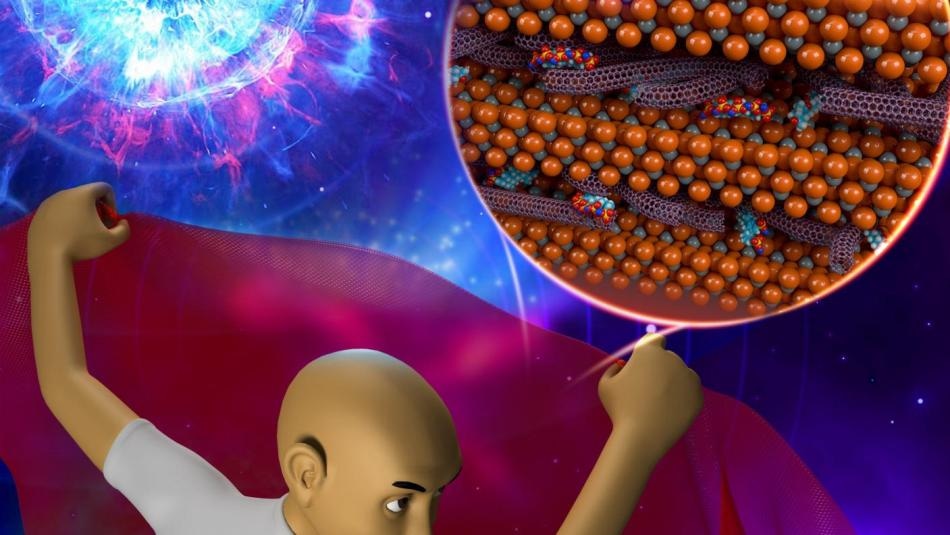Nov 2 2018
Electromagnetic interference (EMI), which can harm drones, smartphones, chips, tablets, wearables, and even aircraft and human health, is increasing with the booming production of devices that generate it. The market for EM-blocking solutions, which use magnetic or conductive materials, is estimated to exceed $7 billion by 2022.
 André Taylor, associate professor of chemical and biomolecular engineering and collaborators developed an innovative technique to produce relatively low-cost composite films designed to block electromagnetic interference.
André Taylor, associate professor of chemical and biomolecular engineering and collaborators developed an innovative technique to produce relatively low-cost composite films designed to block electromagnetic interference.
André Taylor, associate professor of chemical and biomolecular engineering at the NYU Tandon School of Engineering, together with a team that included Yury Gogotsi, Distinguished University and Charles T. and Ruth M. Bach Professor Materials Science and Engineering at Drexel University, and Menachem Elimelech, Roberto C. Goizueta Professor of Chemical & Environmental Engineering at Yale University, used an innovative method to create comparatively low-cost EMI-blocking composite films.
The research, “Layer-by-Layer Assembly of Cross-Functional Semi-transparent MXene-Carbon Nanotubes Composite Films for Next-Generation Electromagnetic Interference Shielding,” has been published in the October 31st, 2018 issue of Advanced Functional Materials. Lead authors include Guo-Ming Weng, a post-doctoral fellow at NYU Tandon, and Jinyang Li, associate professor of materials science and engineering at Southwest Jiaotong University, Chengdu, China.
To design the films, the team used spin-spray layer-by-layer processing (SSLbL), a technique Taylor initiated in 2012. The system makes use of mounted spray heads above a spin coater that places sequential nanometer-thick monolayers of oppositely charged compounds on a component, forming superior-quality films in a lot less time than by traditional approaches, such as dip coating.
The process enabled them to style flexible, semi-transparent EMI-shielding film consisting of numerous alternating layers of carbon nanotube (CNT), an oppositely charged titanium carbide called MXene—a group of carbide flakes first engineered by Gogotsi—and polyelectrolytes. Taylor described that those charge features present far more benefits besides EMI shielding.
“As we worked to discern the roles different components play,” he said, “We found that the strong electrostatic and hydrogen bonding between oppositely charged CNT and MXene layers conferred high strength and flexibility.” He further explained that MXene has the twin advantages of being both adsorbing (it easily sticks to a surface) and conductive, which is crucial for blocking EMI. “And since the film itself is semi-transparent, it has the benefit of being applicable as EMI shielding for devices with display screens, such as smartphones. Other kinds of shields—metal for example—are opaque. Shielding is good, but shielding that allows visible light through is even better.”
The SSLbL technique also provides nanometer-level control over the structure of the film, allowing manufacturers to alter specific qualifies such as transparency or conductivity, because it allows for discrete variations in the composition of each layer. By contrast, films made up of a monolayer concoction of polyelectrolytes, nanoparticles, and graphene in a matrix cannot be so altered. Apart from flexibility, high stability, and semi-transparency, the MXene-CNT composite films also exhibited high conductivity, a property vital to electromagnetic shielding because it dispels EM pulses across the film’s surface, weakening and dispersing it.
While manufacturers have displayed interest in EMI shielding composed of carbon nanotubes and graphene integrated with conductive polymer composites, until now, a comparatively fast, economical means of forming an optimal blend of these qualities on a thin flexible film was intangible, explained Taylor.
“The primary interest in adding carbon materials to shielding was to add conductive pathways through the film,” said Taylor. “But the SSLbL system is also much faster than traditional dip coating, in which a component to be shielded is repeatedly dipped in a material, rinsed, then dipped again in another layer, and on and on. That takes days. Our system can create hundreds of bi-layers of alternating MXene and CNT in minutes.”
While spin-spraying restricts component size, Taylor said that, theoretically, the system could produce EMI shielding for components and devices equivalent in diameter to the 12-inch wafers, for which spin-coating is often used as a coating mechanism in the semiconductor sector.
“It is less expensive to produce it this way and faster because of the tighter connection between materials, and the LbL process facilitates the controlled arrangement and assembly of disparate nanostructured materials much better than just depositing repeated layers of a mix on several components. One can envision tuning the desired properties of a cross-functional thin film using a wide range of parameters, nanostructured materials and polyelectrolytes using this system.”